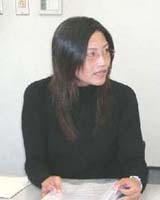
(1)The Japanese term can be read both ways. It is sometimes translated as “I-novel.”
Research Session 1: Japanese Literature in Taiwan: Recognition of the Watakushi shôsetsu/shi shôsetsu (Hosei University, Daigakuin-tô) |
Schedule 11/24/2006 (Friday) |
Report Lee Wen Ju, Tzu Chi University |
 |
This inquiry by Lee Wen Ju into recognition of the watakushi shôsetsu/shi shôsetsu in Taiwan is a large-scale undertaking, involving more than 200 people, especially university students. The result, similar to that of the inquiry in Korea, is that even if they possess a knowledge of the form from study in class and from textbooks, it is difficult to gain an understanding of it in that way. The subject of the second half of the paper is why the watakushi shôsetsu/shi shôsetsu did not develop in China, Taiwan, and Korea, countries which were influenced in no small way by modern Japanese literature. Did it have any influence at all in these countries? Why did it not develop? Further comparative inquiry into modernization and modern literature in these countries is necessary. The influence on Taiwanese literature of rule by Japan, the establishment of Chiang Kaishek’s government, and the language changes that accompanied the shifts in rule, is discussed, as well as the differences with modern Chinese literature. (Umezawa Ayumi) |
| Workshop 1 Research Session 1 Workshop 2 |
|---|
Top Page (The Japanese Watakushi shôsetsu/Shi shôsetsu as Seen in Relation to Asian Culture) Top Page(the Watakushi shôsetsu/shi shôsetsu Research Group of the Graduate School of Hosei University) |
|---|